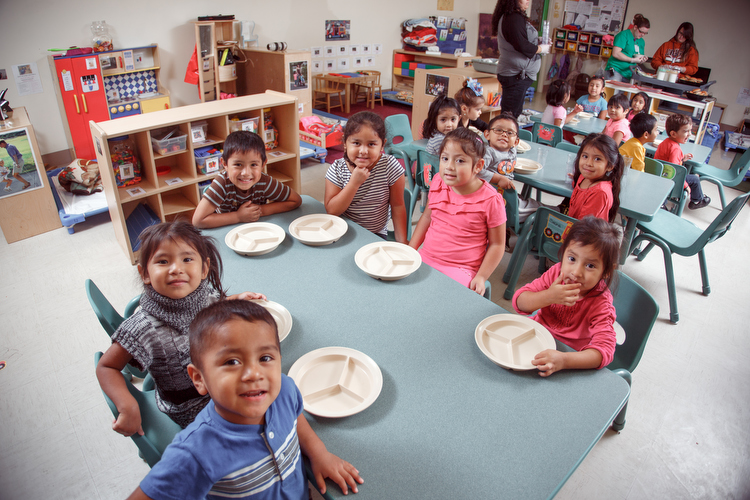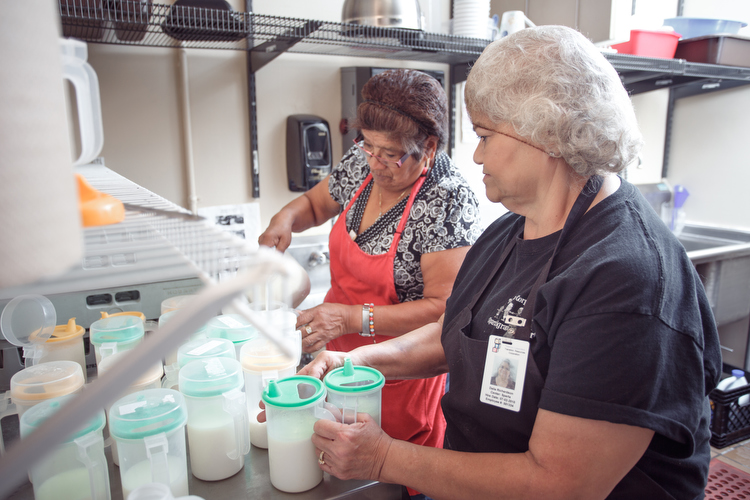Most of the parents of the students at Sergio Rodriguez’s early childhood care facility work as migrant farm laborers in fields and orchards in Kent and Montcalm counties during the growing season.
And even though they are exposed to all sorts of fresh produce, their kids know very little about the fresh fruits and vegetables they harvest, much less the benefits that eating these foods have for their growing bodies and minds, Rodriguez says.
"They (the parents) work long days, sometimes 12 hours or more, and don’t have the time or energy to cook good meals when the family comes together after work," says Rodriguez, who heads a Migrant Head Start program in Sparta run by the
Telamon Corp., a non-profit aid agency that administers a host of educational and social service programming for low-income families in a dozen states. "Sometimes it’s easier for them to say, 'I’m just going to go to McDonald’s and order off the Dollar Menu.'"
But a nutrition program primarily underwritten by the
W.K. Kellogg Foundation, is helping to change that.
The Migrant Head Start program is one of 26 school districts or educational agencies that are recipients in 2016-2017 of grant funds through the state’s Farm to School program, which provides grants up to $2,000 annually to be used for the purchase of fresh produce from Michigan farms. The program is now in its seventh year.
Rodriguez has been able to use these funds to purchase a variety of fresh, locally grown food for his students, who range in age from just several months old up to 5 years and participate in programming that runs from June through early November. Funds have also been used to host programming for parents to teach them about the benefits of eating local, fresh food as well.
In addition, trips to local farms and orchards grew out of the program, as kids became more curious about the food they were eating and where it came from. That interaction with local farmers helped his students become more understanding of the process of how an apple, for example, gets into their hands at snack time.
"When you are able to teach kids how food gets to the table, they are more apt to try new foods than they would normally try," says Rodriguez, who tries to get at least one Michigan grown food item into each of his center’s three meals per day fed to students, nearly all of whom are from Hispanic migrant farmworker families. "Some of these kids have never been exposed to these kinds of food ever before. This program helps to change that."
One of the goals of the
Michigan Good Food Charter is that Michigan institutions will source 20 percent of their products from Michigan food growers, producers, and processors.

The Farm to School initiative focuses around efforts to serve local foods in school and early childcare and education food programs but applies to a variety of initiatives in Michigan, including school garden programs, fundraisers using local agricultural products, farmer visits to school classrooms and cafeterias and field trips to nearby farms.
Abby Harper, Farm to School Specialist at the MSU Center for Regional Food Systems, which helps administer the initiative, says the program opens up sustainable markets for "the entire spectrum of food suppliers" -- from large food distribution services like Gordon’s Food Service to smaller vendors like producers at farmer’s markets -- to offer Michigan-grown produce and meat products.
"School systems are sustainable markets, and like any product supplier, farmers crave consistency in terms of demand," she says. "The nearly year-round nature of the school year means a longer, more dependable market for smaller suppliers, not just at harvest time. Schools build stronger relationships with farmers and the farmers then see themselves as part of the community. This adds a new level of marketing and name recognition, depending on the relationship that’s been built."
Research through the
Center for Regional Food Systems showed that 54 percent of schools engaged in some form of local food procurement in 2014. That percentage is likely to grow, Harper says, as communities and schools become more interested in fresh, locally grown food becoming a consistent part of a daily food profile.
It’s a trend that’s good for all involved.
According to the National Farm to School Network, when students eat more fresh, locally grown food, they are not just more aware of where their food comes from, but are found to have higher academic achievement, better behavior, more social skills, less screen time, and improved self-esteem.
Farmers see an average of a 5-percent increase in revenue by participating in Farm to School initiatives, the network says, in addition to market diversification of their goods. Local economies also benefit from these initiatives, with each dollar invested in the initiative generating an additional $2.16 in local economic activity, while each new Farm to School job contributing to the creation of additional 1.67 jobs in a community, the network says.
Cynthia Pineda does not need to go far to find local, fresh food for her students.
The third-year superintendent of the Boyne Falls Public School system says that in a way, her students are blessed--close-by, there is rich farmland in nearly all directions -- but the Farm to School initiative has helped her procure more of it for her nearly 200 K-12 students, all of whom share the same building.
"It’s pretty great," she says. "We have one farmer who drops off produce right at our back door. Our kids know how lucky they are. We try to use as much organic, Michigan produce as we can. The food is literally going from the farmer right to the kids."
And with almost 60 percent of those kids on free or reduced school lunch programs, the initiative gets organic food in the bellies of kids whose families may not necessarily be able to afford to consistently purchase it on their own. For Pineda, it’s a matter of getting good stuff out of kids after good stuff gets put into them.
"Eating healthy makes a huge difference from an achievement standpoint," she says. "Considering clean food, we really truly believe it's leading to greater focus. After we fill their bellies with good food we see longer periods of attention. At snack breaks in the morning, they grab an apple and read for a bit. It recharges them, gets their brain going. The quality of the food and greater achievement and focus go hand-in-hand."
Her kids' interest in local food led the district to build a hoop house, where a whole assortment of fresh food is grown, from lettuce to tomatoes to cabbage, and where they learn about the growth process and composting.
The district used grant funds for meat products, too, like organic turkey and grass-fed beef from local farms.

Local food has made its way into lesson plans and, like Rodriguez’s students, younger kids at Boyne Falls are taken on trips to local farms to connect deeper with the food they eat at school. And although the $2,000 grant represents only about 10 percent of the district’s annual food budget, it has helped grow its local food focus. Pineda hopes she can leverage the initiative’s funds to procure more grant dollars, she says.
"There is too much upside to feeding kids good food in school," she says. "There is no going back now. We want to keep growing this."
She thought of a pun, too tempting not to use.
"When it comes to feeding our kids, we like to put our money where our mouth is," she says.
Chris Killian has been a writer and journalist in the Kalamazoo area for over 10 years. His work has been published in multiple local publications, including the Kalamazoo Gazette and WMUK. You can find more about Killian, his work, and projects he’s working on by visiting chriskillian.net.
This article is part of Michigan Nightlight, a series of stories about the programs and people that positively impact the lives of Michigan kids. It is made possible with funding from the
W.K. Kellogg Foundation. Read more in the series
here.